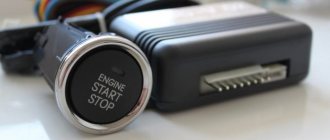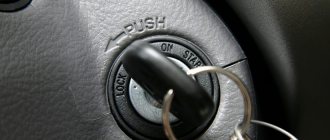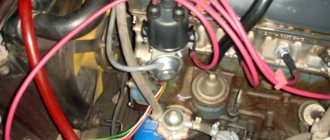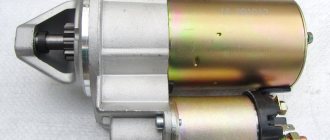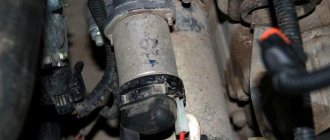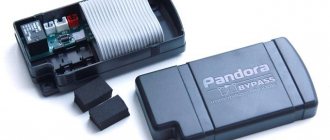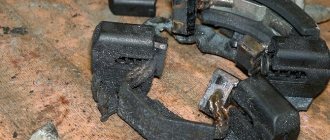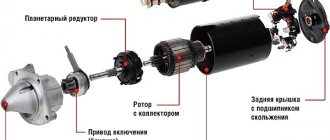In many recent car models, a button is used to start the engine instead of the usual key. How much better and more convenient it is - everyone determines in accordance with their preferences. The appearance of such a new product has caused many drivers to want to install a push-button engine start on their old cars. Therefore, it would be quite appropriate to consider how the ignition and engine starting system can be redesigned in accordance with new trends.
Why is this necessary?
The reasons can be very diverse:
- changed (simplified) engine starting process;
- reducing the number of items in pockets;
- the desire to stand out and many others.
It is best to leave aside attempts to figure out why such a desire arises and understand how to install a button to start the engine (in further text it may be referred to as Start-Stop Engine or abbreviated SSE).
Engine starting system with a button, options for its implementation
It should be noted right away that there are quite a lot of options for connecting the button. This is due to the fact that such a system can be built taking into account a wide variety of initial conditions. As an example, below are some options for how to install such an element, possible operation algorithms of the Start-Stop Engine and the components used. Which one to choose is up to you. If the level of knowledge of electronics and circuits is high enough, you can make your own based on any of the options, you just need to understand the principle.
How the ignition key can be used:
- the key is inserted into the lock, set to position I, and then, after pressing the button, the engine starts (the key allows you to remove the steering wheel lock, which is available on many cars of the VAZ family);
- the key is not used at all, got into the car - pressed Start-Stop Engine, and the engine started.
- What buttons can be used, their installation, connection diagram:
- without locking, in this case it must be pressed and held until the engine starts;
- with fixation, pressed and released, the beginning of stable operation of the motor will be detected by the electronics and the starter will be turned off.
How the ignition system works:
- its start is carried out separately from starting the engine (pressing Start-Stop Engine turns on the ignition, then presses the brake or clutch again and the engine starts);
- the ignition starts working simultaneously with the engine starting;
- Various blocking of the Start-Stop Engine and ignition is carried out, including (the blocking scheme may involve the use of a signal from a security alarm, an open door sensor, turning on the dimensions, etc.).
These are just some of the possible options and algorithms that allow you to start the engine without a key in the car lock.
How to make such a launch possible
As an example, several options for implementing such an idea are considered below. It is worth considering that when undertaking such a modernization, you need to understand and understand what and how to do, because you carry out all manipulations at your own peril and risk. If during the work you have doubts about the correctness of the actions, you should seek advice from a specialist (auto electrician).
Scheme of starting an engine from a button using a key
There are a significant number of different options for implementing this approach. For example, the diagram below.
And below is a diagram of connecting the relay to the ignition switch
Everything works extremely simply. The key is inserted into the lock and turned. Then the button is pressed and held until the motor starts. To turn off the entire system, simply turn the key to its original position. With this option, all functions of the ignition switch and immobilizer are retained.
Installing an engine start button without an ignition key
This is a more complex option that allows you to start the engine using a button; this approach uses, for example, RZPTF (rear fog lamp relay). Its activation is shown in the diagram shown in the figure:
An additional advantage will be connecting power to the alarm system. In this case, the operating algorithm will be as follows:
- the car is removed from the alarm system, power is supplied to pin 1 of the RZPTF, and the backlight turns on;
- the button is pressed and held - the ignition and starter relays are turned on, the starter begins to spin;
- the button is held until the engine starts, then it is released, the starter relay is turned off, the engine continues to run;
- pressing again stops the engine;
- After setting the car to the alarm system, the backlight goes out.
FakeHeader
Comments 8
Please tell me how the standard immobilizer and engine autostart behave after installing this system?
There are no changes in the operation of the immobilizer, since this button is connected to the standard connector of a conventional ignition switch and only performs its function. As for autostart, you need to look at the connection diagram. But since most alarms are connected to the key, the auto start will not see this button. The button simply emits the operation of the key in the ignition switch. But there are a number of disadvantages: the car cannot start from the pusher)) and when the battery is very discharged, the button block takes on a charge and the car does not envy without lighting it.
Most modern cars are designed in such a way that the design of the steering column does not allow the car to be started without a key. At the same time, the question of how to start a car without an ignition key, if it was produced before the mid-90s, practically does not arise. In many films, we see how one of the heroes opens the door of someone else's car and, taking out some contacts and crossing them, starts the engine. The need to start the engine without a key may arise if it is lost.
Contact vulnerability
ATTENTION! A completely simple way to reduce fuel consumption has been found! Don't believe me? An auto mechanic with 15 years of experience also didn’t believe it until he tried it. And now he saves 35,000 rubles a year on gasoline! Read more"
In cars manufactured more than ten years ago, the starter wires are always connected directly to the ignition switch contacts. The engine starts only after the driver turns the ignition key to the extreme position.
This option for connecting the starter is simple and effective. But contacts are always a problem. Moreover, when the starter device is activated, a huge amount of voltage is generated, causing sparking. Where there is a spark, the contacts burn out, oxides accumulate on them, etc. As a result of this, over time, problems arise with starting the engine; motorists are looking for alternative ways to turn on the starter, including directly from the battery.
As you know, in cars of recent years of production, which do not have a button, an additional relay is provided that controls the starter. In this way, the lock contacts are relieved, which now bear less of a load.
- Systems with a separate relay are more reliable because they last longer.
- The ignition switch contacts also “live” much longer.
- An additional relay can always be upgraded.
Combined rework option (step by step)
The necessary materials for tuning are prepared:
- Three types of relays: ZPTF, 4- and 5-pin;
- Several meters of high-quality wiring with a cross-section of more than one millimeter;
- “Start stop” button;
- Diode and terminals.
You should be armed with all the tools necessary for a tuner, including pliers, wire cutters, etc.
The modification scheme looks like this.
Everything is carried out according to the diagram, but the diode can be installed in any convenient place.
How to connect a button to the starter
However, the topic of this article is connecting the starter via a button connected to the same relay. How can this be accomplished?
Connecting a button in a car where there is no additional relay
First of all, you should find the contacts responsible for turning on the starter. Then integrate them with the button.
The modernization algorithm generally looks like this:
- The plastic trim under the steering wheel is disassembled;
- There is a connector connected to the ignition switch contacts (as a rule, this connector has locking tabs);
- Press the tabs to release the connector and pull it out.
As a rule, on older cars, after inspecting the connector, two cables with a large cross-section are found. The red one is responsible for controlling the starter.
Note. You can check whether the wiring is really responsible for controlling the starter like this. Turn the ignition key all the way, short-circuit both wires from the removed connector. If the starter turns on, then that's what they are.
- The button is placed in a place convenient for the driver;
- The found wires are connected to it.
Connecting a button via a relay
In this case, finding the wires responsible for controlling the starter will be much more difficult, because you need to calculate those that are connected to the additional relay.
Experts recommend first ringing all the wires going to the car body with a tester. The identified wires are marked as negative, since they are connected to ground.
Then you need to connect the tester with one end to each of the positive wires, and the other - connect the measuring device to ground. The device itself must be put into a current measurement operating cycle. Test tasks: find a cable that produces 12V when the key is turned all the way.
The main advantages of using a relay in the starter power circuit:
— Such a system is more reliable, since the relay is designed for high currents and lives much longer. — The relay can always be replaced — The contact group behind the ignition key works for a very long time, since it only turns on the relay that takes the main load.
Regardless of whether your starter is turned on by a relay or directly by a contact group, all operations to connect the starter are still performed by turning the key.
First you need to determine which contacts are responsible for the start and connect them to the start button.
To do this, you need to disassemble the plastic protection under the steering wheel of your car. Very often, a connector with all the necessary wires is connected to the contact group of the key well at the back. There should be locking tabs on both sides of this connector. You need to press on them and pull out the connector.
If you have an old car, inspecting the contact group connector you will most likely find the two thickest wires. Very often one of them is red - these wires are directly connected to the starter. If you connect them with the ignition key turned, your starter will most likely start spinning.
Then you can go the simple way. You can simply install the button and connect these two wires to it, placing the button in a place convenient for you. The button should be non-latching, that is, when pressed, it should close the contacts, and immediately after you release it, open it.
Do not forget that you will operate the button in the same way as a key. We press the button, wait until the starter spins, and as soon as the engine starts, release the button.
But do not forget that very large currents will pass through the button and most likely such a button will burn out.
We used a vandal-proof chrome button - it failed after about half a year.
If you have a newer car and the starter in it is connected using a relay, you will need to find among the many wires exactly those that are responsible for controlling the relay.
To do this, you can ring the tester in resistance measurement mode on all the wires on the car body. All wires that ring are marked as ground (or minus), since they are all shorted to the body.
Next, touch each of the remaining wires with one tester probe and the other probe to the body in voltage measurement mode.
We need to find the wire on which 12 Volts appears exactly at the moment you turn the key, that is, when your starter starts spinning.
Button recommendations
It is desirable that the button does not have various latches inside. In other words, the button should instantly engage the starter and disable it as soon as the button is released. The locking button works a little differently. You have to press it twice to turn off the starter, and this is not so much inconvenient as it is harmful to the starter.
In a word, the principle of operation of the button comes down to the following: the driver holds the button pressed until the engine starts, then releases it, the starter turns off. It turns out to be a convenient option when you operate the button like a key.
The button material also needs to be selected wisely. You should take into account the fact that the button itself can burn out due to the passage of large currents through it. For example, a button made of anti-vandal chrome material fails after just 6 months of use, despite the fact that it is designed for high loads.
Keyless start button
It is quite obvious that the starter button in a car increases the ease of use of the vehicle. The standard versions require a mandatory combination of such a Push-Start button with the possibility of Key-Less-Go keyless entry. This combination allows the owner to free himself from the need to use the usual ignition key, replacing it with the so-called electronic key.
Without going into details, an electronic key is a tag by which the owner is identified by anti-theft and other car systems after approaching the vehicle at a certain distance. As for the engine start button, it will only work if the electronic key is in the car.
In practice it looks like this:
- the owner of the electronic key approaches the car;
- at a certain distance, car systems identify the owner by exchanging signals with an electronic key tag;
- then the owner presses a button on the electronic key or simply approaches the car closely;
- after this the door locks are unlocked;
- the driver sits in the seat and presses the engine start button;
It turns out that the electronic key is used by the owner only to forcefully open and close the car doors. The keyless entry and start system performs all other actions automatically. Now let's talk about installing the Start-Stop Engine button yourself.
Popular ways to install the starter button
Let's start with the fact that many car owners are attracted by the very possibility of starting and stopping the engine with a button, that is, not using the ignition key in the lock. In parallel with this, additional implementation of a keyless entry system is not expected. It is worth noting that in the case of such an installation scheme, comfort increases, but safety suffers. The fact is that after attackers enter the car, the engine start button is not blocked by anything, since there are no systems that identify the owner.
- One of the simplest installation options is the starter button, which involves the parallel use of the ignition switch. With this installation scheme, the ignition is turned on using the key in the lock, and the engine itself is then started from the button. Note that this method has more disadvantages than advantages, since the presence of a “start-stop” button still does not provide the required degree of ease of use.
- Another type of installation for starting an engine with a button is the ability to start the internal combustion engine with the gas pedal pressed for models with automatic transmission and the clutch pedal for vehicles with manual transmission. This scheme involves turning on the ignition from the Start-Stop button, while the engine is started directly after pressing the gas or clutch pedal.
- It is also worth mentioning the method of starting the engine from the starter button, subject to parallel pressing of the brake pedal. The convenience of this solution is questioned by many, especially if the car suddenly stalls in traffic. Let us add that linking the start-stop button with the gas, brake or clutch pedals in various schemes will require installing a separate sensor on the pedal involved.
- The installation of an engine start button with a “delay” deserves special attention. This method of non-standard installation has the least detrimental effect on the starter. The downside is the complexity of installation, which requires turning to professionals and making a number of changes to various car systems.
It turns out that the available installation methods can be divided into the following:
- the engine start button only activates the ignition; the start itself occurs after pressing the brake, gas or clutch pedal;
- the start-stop button allows you to both turn on the ignition and start the engine;
- full installation of an engine start system from a button in combination with the installation of a keyless entry system into the car;
Advantages and disadvantages
Initially, it seems that the button has a number of advantages. After all, the driver just needs to press it and the car will start. There is no need to turn the key.
But don't rush to conclusions. Also, don’t rush to Aliexpress for a new button. Even though the price of such devices is insignificant, I first advise you to study the strengths and weaknesses of such a step. Let's start with the advantages, which include the following:
- There is no need to use a key every time you want to start a car engine;
- The button launch scheme is extremely simple;
- Installation is possible on many cars;
- The level of comfort increases;
- Start-Stop can be linked quite effectively to the alarm and immobilizer;
- The price of the button is low;
- Many drivers can install the system themselves, relying on instructions and video lessons;
- The work takes no more than a few hours.
Everything looks very rosy and promising. But take your time. There are pitfalls here.
The driver will have to press the brake to start. Not the most familiar scheme, which will take some getting used to. There are also difficulties in installing an alarm system with an autostart system, where the engine start button is located.
Self-installation of the engine start button
To better understand the issue, it is necessary to briefly consider the standard process of starting the engine on cars that are equipped from the factory with a simple ignition switch. In such cars, the power wires from the starter are connected to the contact group of the ignition switch. After turning the key in the lock, the contacts close. This solution is found on older car models. The fact is that a large current passes through the contacts, which leads to rapid burnout.
For this reason, more modern versions received a separate relay. The task of such a relay is to take on the entire load and close the contacts after turning the key in the ignition switch. The ability of the relay to cope with high loads, as well as the ease of replacing this element in the event of its failure, allows us to speak about the reliability of the system. As a result, the service life of the contact group has increased significantly.
To connect the engine start button, it is necessary to determine exactly which contacts are responsible for closing the power to the starter, which allows you to crank the crankshaft with the starter using the button and start the engine, as well as stop the power unit by opening the contacts. These contacts are connected to the engine start button or other elements (depending on the installation diagram), allowing you to completely bypass the key in the ignition switch.
- To connect, you need to remove the decorative and protective elements on the steering column to gain access to the wiring. The final goal is the connector located on the back of the ignition switch contact group. The specified connector must be disconnected by snapping off the special latches. On machines without a relay, you will need to find power wires in the contact group that are directly connected to the starter contacts. For an accurate check, you can turn on the ignition in the lock using the key, and then short-circuit the found wires (often these are the two wires with the largest cross-section). The start of the starter after the wires are closed will indicate that the contacts are selected correctly.
- The next step is to connect the start-stop button itself. First, you need to select a location for installing the button on the dashboard or in another suitable place, and then connect the necessary power wires from the ignition switch contact group to it. On cars with a relay, wires are connected to the starter button that supply voltage to the relay. For an accurate determination, you can use a multimeter, which is set to the ohmmeter mode for measuring resistance. First, the tester checks the wires from the starter to the car body, as a result of which the “minus” is determined.
Sequence of operations when installing “start/stop” on the ignition switch
To properly install the device into the system, you must follow the sequence of steps below:
- First, the ignition lock cylinder is removed, followed by the lock itself.
The ignition lock cylinder has been removed from its socket.
Harness of cut wires from the ignition switch
The wires on the ignition unit are carefully wrapped with electrical tape
Start/stop button mounted on the car dashboard
